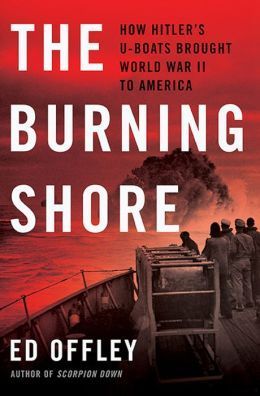Mark Scott Smith's Blog: Enemy in the Mirror, page 113
May 21, 2014
Battle of Kharkov – May 1942

Eastern front May 1942; Wikimedia Commons
(The battle took place in the small orange area with two arrows in the area of Ukraine)
The Soviet winter counteroffensive of 1941-42 succeeded in preventing the Germans from taking Moscow. Exhausted, both sides paused. Then Joseph Stalin, convinced that the German offensive would soon collapse, decided to launch a new spring offensive on the Eastern Front. The May 1942 attack at Kharkov was an initial success, but ferocious Wehrmacht fighting, the arrival of the Luftwaffe and Soviet errors turned the battle into a debacle for the Russian forces.
Read more: Second Battle of Kharkov – Wikipedia, the free encyclopedia.
The post Battle of Kharkov – May 1942 appeared first on Enemy in the Mirror.
May 19, 2014
Spring 1942 – Was a Japanese Invasion of USA Possible?

Daily Mail, U.K.
In order to secure needed natural resources, Imperial Japan attempted to establish a Greater Asian Co-Prosperity Sphere with Japanese control. The U.S. Navy (and to a lesser extent, Royal Navy) were a threat to the development of this plan. The December 1941 attack on Pearl Harbor might be viewed as a logical attempt to neutralize this perceived threat.
In early 1942 many Americans believed that Japan was planning an attack on West Coast military targets such as the port facilities, military equipment and aircraft manufacturing plants of San Diego, San Francisco, Portland and Seattle.
But an attack on the continental United States would have been logistically next to impossible. An invasion force large enough to occupy West Coast cities would have required massive logistical support. A general military concept is that a small invasion force can travel long distances, but transporting and supplying a a large force can only be completed with proximity to the point of attack (e.g. England to Normandy or Okinawa to Japan).
Likewise, in order to carry out simple raids raids (without landing large invasion forces) on the West Coast, Japan would have needed to occupy Pearl Harbor. But Hawaii was not invaded at the time of the Pearl Harbor attack because the Japanese lacked the logistical capability to do so, and because the USA still had substantial forces in the western Pacific.
Nevertheless, in early 1942 many West Coast citizens (and officials who should have known better) had a level of concern regarding Japanese attack that bordered on hysteria.
Read more opinion:
Was a Japanese Invasion Possible?.
The Axis Plan to Invade America in 1942
Invasion U.S.A. – The Various Plans to Conquer America
The post Spring 1942 – Was a Japanese Invasion of USA Possible? appeared first on Enemy in the Mirror.
May 16, 2014
Battle of the Coral Sea – May 1942
In early May 1942, Japanese forces invaded and occupied Port Moresby in New Guinea and Tulagi in the southeastern Solomon Islands.
From May 4-8, 1942 the Imperial Japanese Navy engaged in a major aircraft battle with naval and air forces of the United States and Australia. The resulting Battle of the Coral Sea was the first time that enemy aircraft carriers engaged each other (although ships on neither side actually sighted or fired directly upon the other).
Although Japanese aircraft sank more Allied ships than vice versa, overall, the Battle of the Coral Sea marked the first reversal of Japanese advances in the Pacific War and is regarded as a strategic victory for the Allies. Perhaps most importantly, the Japanese fleet carriers Shōkaku and Zuikaku were seriously damaged and would be unable to participate in the upcoming June Battle of Midway.
The post Battle of the Coral Sea – May 1942 appeared first on Enemy in the Mirror.
May 14, 2014
The Burning Shore – Paukenschlag 1942
The war reached North America in January 1942 with the beginning of Paukenschlag (Operation Drumbeat) orchestrated by Vice Admiral Karl Dönitz. Most American naval resources at the time were involved in North Atlantic convoys and the Atlantic and Gulf Coasts were unprepared for defense against U-boat attacks.
Along the coast, ships sailed with no convoy protection, and civilian reluctance to conform with (initially) voluntary blackouts kept shore lights burning and ships silhouetted as easy targets for U-boats. During the first 6 months of 1942 U-boats sank or damaged hundreds of ships. More American seamen died in these attacks than were killed in the attack on Pearl Harbor.
This fascinating book relates the events occurring during the desperate first half of 1942 through the eyes of a U-boat commander and a U.S. Army Air Force bomber pilot.
The post The Burning Shore – Paukenschlag 1942 appeared first on Enemy in the Mirror.
May 13, 2014
Ghostly Images WWII-Present

enhanced-buzz-wide-13321-1398699758-7
This post is haunting.
View: 26 Ghostly Images Of World War Two, Blended With The Present.
The post Ghostly Images WWII-Present appeared first on Enemy in the Mirror.
May 12, 2014
Ration Books Issued – USA May 1942

via: http://www.ameshistory.org/exhibits/e...
When the USA entered the war, the economy switched over to an emphasis on military production with consumer goods a low priority. The U.S. Office of Price Administration (OPA) froze prices on most everyday goods (e.g., gasoline, tires, sugar, meat, silk, shoes, nylon). In May 1942, war ration books and tokens were issued to each family, prescribing the amount an individual could purchase.
Read this interesting post: Rationing on the US Homefront during WW II.
The post Ration Books Issued – USA May 1942 appeared first on Enemy in the Mirror.
May 9, 2014
U-Boat Sunk Off Cape Hatteras – April 1942

Type VIIB U-Boat; Wikimedia Commons
The German U-85 was sunk with all hands on 14 April off the United States coast near Cape Hatteras by gunfire from the American destroyer USS Roper.
The U-85 was was the first German U-boat loss of “Operation Drumbeat” (Paukenschlag), off the eastern seaboard of the United States.
The post U-Boat Sunk Off Cape Hatteras – April 1942 appeared first on Enemy in the Mirror.
Type VIIB U-Boat; Wikimedia Commons
The German U-85 was s...

Type VIIB U-Boat; Wikimedia Commons
The German U-85 was sunk with all hands on 14 April off the United States coast near Cape Hatteras by gunfire from the American destroyer USS Roper.
The U-85 was was the first German U-boat loss of “Operation Drumbeat” (Paukenschlag), off the eastern seaboard of the United States.
The post appeared first on Enemy in the Mirror.
Maximal Japanese Advances – May 1942

Wikimedia Commons
By the end of May 1942, Imperial Japan had expanded its occupied territories westward to the border of India, south to New Guinea (but short of Australia), east to the Midway Islands and north to Manchuria and the Kamchatka peninsula of the USSR. This was to be the full extent of Japanese domination in WWII and the beginning of a defensive battle to protect the territory taken and, ultimately, the homeland of Japan itself.
The post Maximal Japanese Advances – May 1942 appeared first on Enemy in the Mirror.
May 7, 2014
Baedeker Raids on England – 1942

1937 Baedeker travel guide ; Wikimedia Commons
After the RAF attack on the lovely medieval city of Lübeck in March 1942, the Germans launched a campaign of air raids on historic British towns listed in the popular Baedeker travel guide. Included as targets were Canterbury, Exeter, Bath, Norwich, and York. The Nazi propagandist Baron Gustav Braun von Sturm declared, “We shall go out and bomb every building in Britain marked with three stars in the Baedeker guide.”
The post Baedeker Raids on England – 1942 appeared first on Enemy in the Mirror.
Enemy in the Mirror
I began by posting events around the turn This website www.enemyinmirror.com explores the consciousness, diplomacy, emotion, prejudice and psychology of 20th Century America and her enemies in wartime.
I began by posting events around the turn of the 20th century as I was researching my first novel about the Pacific War. I continued through WWII for my second novel about the Battle of the Atlantic. Now I am beginning to look at the Cold War as I gather information for my next novel about the Korean War. ...more
- Mark Scott Smith's profile
- 7 followers




